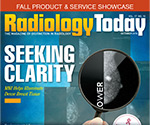 |
There has been some debate recently about when women should start regular mammograms and how often they should get them. There has also been a push for value-based care. Because mammography is accompanied by a broad range of outcome measures, researchers at Johns Hopkins Hospital decided to study how value-based care might affect mammography. Although the researchers didn’t examine specific practices, their study suggests that radiologists can take a more active role in helping women access preventive care. Additionally, their findings on mammography frequency may surprise you.
— Dave Yeager, editor |
 |
 |
Health Care Reforms Spur Increase
in Screening Mammography
The Medicare Shared Savings Program (MSSP) has produced small but significant improvements in mammography utilization in its first three years, according to a new study published online in the journal Radiology.
Established as part of the Affordable Care Act (ACA), MSSP is intended to improve the quality of care for Medicare Fee-For-Service beneficiaries while reducing unnecessary costs. The program affords eligible providers, hospitals, and suppliers an opportunity to create or participate in Accountable Care Organizations (ACOs). MSSP represents the largest value-based population reimbursement program in US history.
“The ACA encourages experimentation with alternative-payment models like value-based programs,” says study lead author Anand Narayan, MD, PhD, of Johns Hopkins Hospital in Baltimore. “In the value-based model, instead of being paid for doing more tests and procedures, providers get fixed payments tied to measures of whether they are doing a good job or not.”
While these measures are still coming into focus across medicine, mammography is uniquely situated to measure quality with a robust array of measures tracking outcomes of screening studies.
Narayan and colleagues recently evaluated the impact of MSSP ACOs on mammography screening utilization through a study of Medicare data on women between the ages of 40 and 69 who underwent screening between 2012 and 2014. ACOs in the MSSP demonstrated a mean increase in mammography screening utilization of 2.6% from 2012 to 2014, with 128 of 208 ACOs, or 61.6%, reporting improvements. The improved screening adherence ran counter to the trend in traditional fee-for-service populations, where mammography screening was unchanged or declined over the same time periods.
Full story » |
 |
|
|
 |
Setting the Pace
MRI has become more widely used in recent years, including in the segment of the population that has implanted cardiac devices. As a result, extra safety precautions must be taken. Read more »
Addressing Mammography’s Prior Problem
The importance of prior studies for comparison in mammography reading is no secret to breast imagers, but limited resources and lack of knowledge often limit access to previous images. Read more »
Environmental Concerns
Ergonomically designed reading rooms can help improve the flow and quality of work, but many radiologists are still, for a variety of reasons, working in subpar rooms. Read more »
Seeking Clarity
Radiologists still debate which modality provides the clearest view through the white cloud of dense breast tissue, but the early results of molecular breast imaging show promise. Read more » |
 |
|
